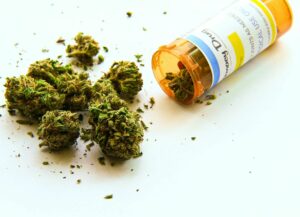More than 100 million Americans are living with chronic pain—an “epidemic of pain” that costs billions every year in treatment and lost productivity. Treatment for that pain relies heavily on opioids, a class of potent prescription painkillers, and other medications aimed at treating pain-related symptoms like insomnia or depression. But opioids come with a long list of potentially dangerous side effects as well as a high risk of addiction and death from overdose—and studies have shown that for chronic, rather than acute pain, they aren’t really all that effective anyway.
Because of the risks and side effects associated with opioids and other pain medications, a growing number of pain sufferers are seeking out medication-free, holistic treatments that work with the body’s own mechanisms for modulating pain. Among the most effective non-prescription alternatives, according to research, are:
- Exercise
- Pressure point therapies
- Cannabis
FOLLOW US ON FACEBOOK & INSTAGRAM
What Causes Chronic Pain?
Just about everyone experiences pain. While a very small group of people are almost completely lacking in pain receptors, most of us are equipped with a wide-ranging and sensitive network of neurons that fire in response to painful stimuli, sending signals to the brain that tell us to do something about it.
Acute pain, the kind that comes from a sudden event like an injury or surgery, stimulates regions in the brain that are associated with tissue damage, and those signals trigger a number of responses in the body to deal with the problem. Pain medications like opioids block those pain signals in the brainstem, so that they don’t register as strongly. That’s why opioid medications can be very effective in the short term, such as in the days immediately after major surgery, or when healing from an injury.
But brain imaging studies show that chronic pain generally behaves very differently. Even after an injury or other tissue trauma has healed, the perception of pain can linger. This kind of pain manifests in areas of the brain such as the limbic system and prefrontal cortex, areas of the brain associated with memory, emotion and learning. The brain is an eternally plastic organ, capable of building new neural pathways in response to constant input and stimulation—and of retiring others that don’t receive new input.
In patients with chronic pain, the connections between memory, emotion and pain can become rewired, laying down new and stronger pathways that persist even after the initial injury or trauma is long over. Some research suggests that chronic pain sufferers may be more susceptible to experiencing this kind of pain, because their brains are more sensitive to pain signals that then become stored in memory.
Medications Don’t Always Help Ease Chronic Pain
Because opioids block pain signaling, they can provide short-term relief for pain that comes from signaling in the central nervous system that reaches the cerebral cortex. But when they’re used for chronic pain conditions such as arthritis, back pain or fibromyalgia, or even lingering pain from a past injury, their effectiveness drops to around 50–60%.
Even so, a majority of doctors continue to prescribe them for 90 days or longer—or indefinitely—in spite of recommendations from the Centers for Disease Control that they be used for seven to 10 days, or no more than a month. Opioids can become addictive very quickly, leading to long-term abuse and the risk of overdose death.
Along with opioids, a number of other medications are often prescribed to relieve symptoms associated with chronic pain, such as insomnia, anxiety or depression. These drugs bring their own side effects and risks, and typically don’t directly address the causes of chronic pain itself.
But non-pharmaceutical approaches to managing chronic pain focus on supporting natural pain-relieving processes in the body and brain. This can help relieve both pain and other symptoms that go along with it.
Exercise Promotes Pain Relief
If you’re in pain, you may not feel like working out, but movement can boost the flow of blood and oxygen, and engage the body’s own pain modulating systems. “Runner’s high” isn’t limited only to endurance athletes—exercise, especially the aerobic variety, stimulates the production of endorphins and other naturally occurring chemicals that block pain signals and promote feelings of well-being.
Certain kinds of exercise can also do more. Meditative movement practices such as yoga or tai chi encourage flexibility and stretching, which can help muscles that tighten in response to pain. These kinds of practices can also encourage the brain to build new pathways that counteract the changes caused by chronic pain. Some studies suggest that yoga and similar practices can be as effective as prescription pain medications.
Massage & Acupuncture Ease Pain
Some [alternative therapies focus on easing pain by targeting specific points](https://www.onlineholistichealth.com/natural-cure-chronic-pain-syndromes-silenced-medical-doctors/) on the body. Many types of massage therapy involve working on certain areas of the body to relax muscles and release areas that might be experiencing pain. Studies suggest that massage can also encourage the release of chemicals like oxytocin that cause feelings of relaxation and well-being.
Acupuncture has proven to be so beneficial for certain kinds of chronic pain that this ancient Asian treatment has made its way into mainstream recommendations for pain relief, even though it still isn’t clear how it works. Some research suggests that acupuncture needles trigger the release of aminase, an amino acid in the skin that helps reduce pain signals.
Cannabis Relieves Pain—& More
A long list of natural remedies can also help relieve chronic pain, such as omega 3 fatty acids to ease inflammation, and vitamin and mineral supplements to support nerve and tissue health. But a growing number of chronic pain sufferers are turning to cannabis products of all kinds for pain relief that also helps related symptoms such as insomnia and anxiety.
Compounds in marijuana, especially cannabidiol (CBD), bind with the body’s natural endocannabinoid receptor system, a wide-ranging network that supports many essential processes, including immune responses, mood and pain signaling.
RELATED: CHRONIC PAIN HAS MET ITS MATCH
CBD and other compounds are so similar to cannabinoids naturally produced by the body that they can trigger the same responses, without the risk of addiction and overdose associated with opioid pain medications. For that reason, marijuana can also help with the sleep problems and anxiety that often accompany chronic pain—and it allows many people to reduce their use of opioids and other medications, or to stop taking them altogether.
For the millions of Americans and others around the globe who are suffering from chronic pain conditions, holistic approaches can provide relief that’s as effective as prescription medications, without their risks and side effects. By supporting the body’s own healing responses, alternatives like exercise, massage and cannabis can offer a way out of the twin epidemics of chronic pain and opioids.
Photo credit: Xavier Sotomayor
If you’re new to cannabis and want to learn more, take a look at our Cannabis 101 post. HelloMD can help you get your medical marijuana recommendation; it’s easy, private and 100% online.






